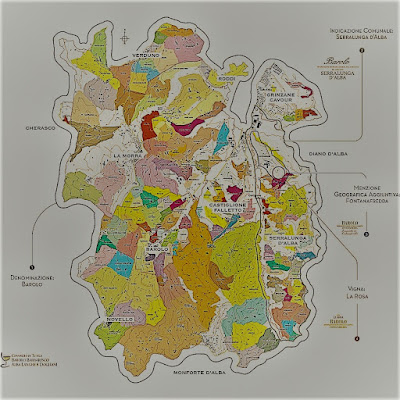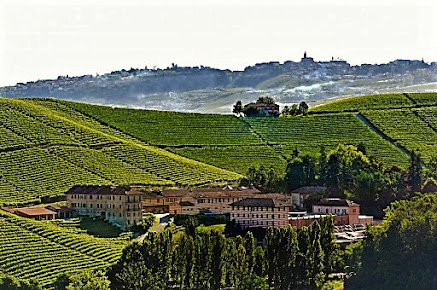Cru and Geographical Units, when changing rules may not be enough
Whenever we talk about the delay of Italian wine compared
to the French one, which, beyond easy trivializations, is an "hard
truth" certified by an average selling price of our wines equal to about
half of theirs, one of the most cited aspects is that of IDENTITY, both in
terms of recognizing the differences between products that are more or less
different from each other and, also and above all, in terms of the evidence of
the quality pyramid.
Topics in which French are authentic masters, while we,
in the vast majority of cases, could consider ourselves at best the scruffy
copyists, able to inventing useless appellations or spending days debating the
reason – to give an example trivial – for which the consumer is not willing to
spend 15-20 euros for a good Chianti Classico when wines of dubious origin are
allowed to boast same "title" and be offered for three euros, (if not
less), on the shelf of many supermarkets.
In this regard, the terms those that everyone invokes as
if just naming them constituted a sort of solution of all matters that limit
our wine (which for honesty and completeness of information also has numerous strengths) are those of ADDITIONAL GEOGRAPHIC
UNIT and CRU.
Concepts that are often overlaid and confused with one
another but which in reality refer to profoundly different areas, although they
can be used together.
In fact, while the ADDITIONAL GEOGRAPHIC UNIT (often
abbreviated through the disturbing acronym UGA and regulatory evolution of the
Additional Geographical Mentions used for some time within Barolo and
Barbaresco DOCG) is a purely territorial term, which identifies a more
restricted area within the territory of a specific appellation, the concept of
CRU outlines a completely different meaning, linked to a hierarchical and
pyramidal setting of the quality of the final product and therefore of its
prestige and rank.
The place where the two concepts blend wonderfully,
almost becoming a single entity is evidently Cote d'Or, where the geographical
connotation is identified through the various climats/lieux-dits located within
the different municipalities, while the qualitative pyramid is determined by
the rank they possess, be it Village, Premier Cru or Grand Cru.
Coming to the italian matters, for long time a sort of
new classification of Italian wine has been asked, if not general at least
relative to the most important territories, and I think it would be a very good
thing, but to avoid to make the classic (as well as usual) mistakes, I believe
that a fundamental upstream job is needed, as well as a cultural leap on the
part of all the players in our supply chain, producers in the lead.
In fact, before leaving to talk about classifications and
hierarchies, it would be of capital importance to set up a meticulous – and
above all authoritative – work of identifying the different sub-areas making up
the territories under analysis and their geological profiles, the starting point
in the path of identification of the various that compose them and therefore
for the definition of the quality pyramid.
An activity that, as already mentioned, was carried out
almost exclusively for the two most important and Piedmontese DOCGs (thanks to
the impetus of the enormous work carried out over the years by Alessandro
Masnaghetti), while – beyond improvised and self-assigned references – in fact
it doesn’t exist elsewhere.
Furthermore, a pyramidal classification has meaning, or
rather it’s possible, only in these contexts in which various terroirs express
different and above all recognizable characters in the wine.
I am thinking of Langhe, Montalcino, Etna and Taurasi
area, but also some climats within the Chianti Classico or South-Tyrol, less
territories in which – beyond the absolute value of the wines that may arise
from them – the result is overwhelmingly influenced by the technical skills
(excellent or not) of the different wineries.
Areas in which the wines are natural expression of the
earth, son of the vineyard rather than of the cellar, and in which the vigneron’s
knowledge and skills end up being a sort of complementary activity aimed at
expressing in the glass the full potential that each terroir possesses.
Potential – that differs to case and case – at the base
of the subsequent hierarchical scale and of the concept of Cru.
But beyond this, even the actors in this film, be they
institutions, consortia or producers themselves, must play a role of capital
importance in this hypothetical change.
And they must do it because in the country where everyone,
to try to emerge ends up obscuring the panorama of everyone including their own,
a change of mentality is really necessary, leading to the recognition of own
limitations and the merits of others.
A sort of cultural revolution of Italian wine, in which
we all work together to give identity to the territory, to bring out the
differences and help the consumer to understand what he drinks and choose what
he really prefers instead of looking for every possible subterfuge to confuse
him, if not really to screw him.
Here, and I am speaking from direct experience, there are
still producers who instead of telling themselves they end up talking about his
famous vineyard’s neighbor, accusing him of who knows what wickedness simply to
feel less worse than they really are, while in France , although he does not
have many real examples to bring, I am sure that any vigneron of any
appellation would be the first to pontificate and praise the
"important" neighbor, but not only for education and deference, but
also and above all for interest.
Because he knows very well that the success of those who
live within his own territory, will consequently bring great benefits to him
too, turning on the spotlight on the entire appellation and allowing him to
sell their wines likely at a much higher price than they would otherwise have
ripped off.
It seems trivial, I know, but in the country where merit
is utopia, where competence and success generate blame and envy rather than
admiration and a sense of emulation, in which instead of discussing quality and
varietal adherence, we discuss protocols often without any scientific basis, in
which defects are passed off as a defense of tradition, everything is possible.
Even to change everything, ending up putting in place a "revolution"
made up of endless geographical references and hierarchical classifications in
which the top of the pyramid is much more clogged than the base itself, without
changing anything.









turismoformativo è un'attività di web marketing turistico che si rivolge a chi desidera aprire un'agenzia viaggi online. TurismoFormativo offre un corso di web marketing turistico multidisciplinare per assistere ed aiutare appassionati di viaggi e turismo e neoimprenditori che vogliono affacciarsi sul marketing online nel settore turistico. Attraverso un blog tematico rivolto prettamente al settore delle agenzie viaggi,i lettori possono mantenersi informati sugli aspetti legati al marketing turistico per pianificare l'avvio di un'agenzia viaggi online.turismoformativo
RispondiElimina#Turismoformativo